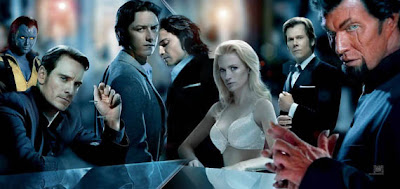The above clip is my favorite, not because I pine for fight scenes in superhero flicks but because by it, mutant is defined as “better men”. In this part of the movie we discover both where Magneto (Michael Fassbender) gained his signature helmet and Xavier (James McAvoy) lost the ability to walk. The drama combining Charles’ demonstration of his tenet, Erik’s culmination of his resentful heart & the helpless situation of the U.S. & Russian forces (world’s superpowers the time the movie was supposed to be plotted) made this part the highlight of X-Men: First Class movie.
Being a late bloomer in the X-Men fad, I started “liking” the characters and their mutant capabilities when the first movie of the franchise was released in 2000. I was aware of the cartoon series when I was little but I never got to really follow like other kids did who grew up at the same time I did. Nonetheless, despite the lack of history, the trilogy that came between 2000 and 2006 afforded enough familiarity towards this prequel. It focuses on "the formative years of Xavier and Magneto, and the formation of the school and where their relationship took a wrong turn." [Fleming, Michael (2009-12-17). "Bryan Singer to direct 'X-Men: First Class'"]
This prequel film showcases mutants, both new and the familiar. Mystique (Jennifer Lawrence) & Beast (Nicholas Hoult) are probably the most well known. The recruit Banshee (Caleb Jones) is quite amusing. He can produce glass-shattering screams and sonar. Another recruit is Adam Summers (Lucas Till), known as Havoc. He can create arcs of red energy around his body. All along I thought he was Cyclops and I was waiting for the scene where that red energy will come from his eyes (pun intended).
Just as the film is entitled “First Class”, it really is just that—a prologue. Of course it’s geared towards discovering the origins of some, but the only coherence I learned were those of Xavier’s and Magneto’s beginnings. The vibrancy of the plot is made-up around the difference of ideals between these two characters. Charles Xavier wants to intermingle with humanity thus seeking cooperation & peace. Erik (Magneto), on the other hand, fueled by a sore past, believes that mutants will never be accepted so he pushes for dominance and superiority.

I find Mystique’s “relationships” with Xavier and Beast inconsistent with the first trilogy’s story line. I find no trace of this past association in the character of Mystique. Furthermore, how can Mystique be a teenager in 1960 and middle aged in 2000? There may be an explanation by X-Men geeks out there so if you read this blog, please let me know. That may also be true for Beast.

The good thing about my experience with this movie is that I don’t have to be an X-Men geek to keep track of what’s going on & enjoy. For a superhero motion picture as classic as X-Men to make its mark, a strong villain character is needed. Sebastian Shaw (Kevin Bacon) and his band of mutants known as the Hellfire Club provided that worthy opposition. Their role is to intimidate US & Russian political “biggies” to take steps towards war. This is when the X-Men intervenes. Driven by personal purpose, Erik joins Charles’ cause to avert war only to put to action his long awaited arrangement with his past, to avenge his mother’s death and usher Shaw’s demise. The integration of Shaw’s character and his being villain made this film a more anticipated flick as it contributes to raising the bar for all superhero movies.
Despite negligible inconsistencies, the movie delivered what it ought to deliver. The cast were brilliant enough to complete each other. I take on the counsel of Xavier to Erik: There's so much more to you than you know. Not just pain and anger. There's good in you too, and you can harness all that.
The balance, the control of power is what this movie is all about. In the end, the more rational means of the interpretation of right or the good triumphs. The sequels carried the same theme and this First Class definitely stands out as a clear-headed introduction.





